Transport in Venezuela revolves around a system of highways and airports. Venezuela is connected to the world primarily via air and sea. In the south and east the Amazon rainforest region has limited cross-border transport; in the west, there is a mountainous border of over 1,375 miles (2,213 km) shared with Colombia. The Orinoco River is navigable by oceangoing vessels up to 400 km inland, and connects the major industrial city of Ciudad Guayana to the Atlantic Ocean.
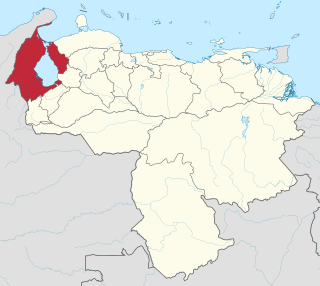
Zulia State is one of the 23 states of Venezuela. The state capital is Maracaibo. As of the 2011 census, it has a population of 3,704,404, the largest population among Venezuela's states. It is also one of the few states in Venezuela in which voseo is widespread. The state is coterminous with the eponymous region of Zulia.

The Venezuelan War of Independence (1810–1823) was one of the Spanish American wars of independence of the early nineteenth century, when independence movements in Latin America fought against rule by the Spanish Empire, emboldened by Spain's troubles in the Napoleonic Wars.
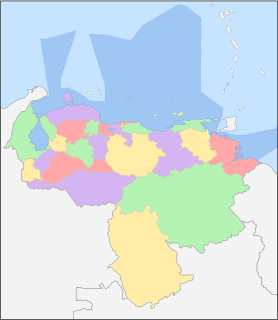
Venezuela is a federation made up of twenty-three states, a Capital District and the Federal Dependencies, which consist of many islands and islets on the Caribbean Sea. Venezuela also claims the Guayana Esequiba territory which comprises six districts in the independent nation of Guyana.

The Venezuelan Declaration of Independence is a statement adopted by a congress of Venezuelan provinces on July 5, 1811, through which Venezuelans made the decision to separate from the Spanish Crown in order to establish a new nation based on the premises of equality of individuals, abolition of censorship and dedication to freedom of expression. These principles were enshrined as a constitutional principal for the new nation and were radically opposed to the political, cultural, and social practices that had existed during three hundred years of colonization.

José Cristóbal Hurtado de Mendoza y Montilla, commonly known as Cristóbal Mendoza, was a Venezuelan lawyer, politician, writer, and academic. Cristobal is best known for serving as the first official President of Venezuela from 1811 to 1812. After earning a master's degree in philosophy in Caracas and his doctor utriusque juris in the Dominican Republic, early in his professional career he served in various law firms in Trujillo, Mérida, and Caracas. He moved to Barinas in 1796 to practice law, and in 1807 was elected Mayor of Barinas. In 1810, Mendoza joined the insurgent movement started by wealthy Caracan citizens against the Spanish crown, and in 1811 was elected to represent the province of Barinas in the newly founded Constituent Congress of Venezuela. Days later he was appointed the first president of the First Republic of Venezuela, a role he shared as part of a triumvirate. Until his term ended in March 1812, Mendoza began the war for independence against the parts of Venezuela that still supported the Spanish monarchy, authored the Venezuelan Declaration of Independence, and also took part in constructing the first Constitution of the Republic of Venezuela.

The Captaincy General of Venezuela, also known as the Kingdom of Venezuela, was an administrative district of colonial Spain, created on September 8, 1777, through the Royal Decree of Graces of 1777, to provide more autonomy for the provinces of Venezuela, previously under the jurisdiction of the Audiencia of Santo Domingo and then the Viceroyalty of New Granada. It established a unified government in political (governorship), military, fiscal (intendancy) and judicial (audiencia) affairs. Its creation was part of the Bourbon Reforms and laid the groundwork for the future nation of Venezuela, in particular by orienting the province of Maracaibo towards the province of Caracas.

The United Provinces of New Granada was a country in South America from 1811 to 1816, a period known in Colombian history as the Patria Boba. It was formed from areas of the New Kingdom of Granada, roughly corresponding to the territory of modern-day Colombia. The government was a federation with a parliamentary system, consisting of a weak executive and strong congress. The country was reconquered by Spain in 1816.
Miss Venezuela 1995 was the 42nd Miss Venezuela pageant, was held in Caracas, Venezuela on September 27, 1995, after weeks of events. The winner of the pageant was Alicia Machado, Miss Yaracuy.
Miss Venezuela 1961 was the 8th edition of Miss Venezuela pageant held at Tamanaco Intercontinental Hotel in Caracas, Venezuela, on July 1, 1961. The winner of the pageant was Ana Griselda Vegas, Miss Caracas.
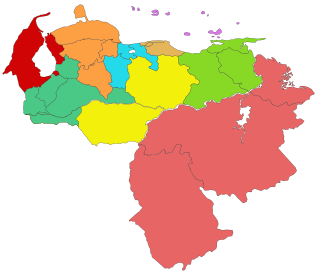
The Zulian Region is one of the 10 administrative regions into which Venezuela is divided for its development plans. This region is coterminous with Zulia State and is administrated by CORPOZULIA. The people from this region seek autonomy from the central government.
The Republic of Gran Colombia was a former independent country in northern South America, a post-Spanish colonial country that existed from 1819 to 1831. Its initial subdivisions, created in 1820, were revised and expanded in 1824.

The Venezuela Province was a province of the Spanish Empire, of Gran Colombia (1824-1830) and later of Venezuela, apart from an interlude when it was contracted as a concession by the King of Spain to the German Welser banking family, as Klein-Venedig.

New Andalusia Province or Province of Cumaná (1537–1864) was a province of the Spanish Empire, and later of Gran Colombia and Venezuela. It included the territory of present-day Venezuelan states Sucre, Anzoátegui and Monagas. Its most important cities were Cumaná and New Barcelona.
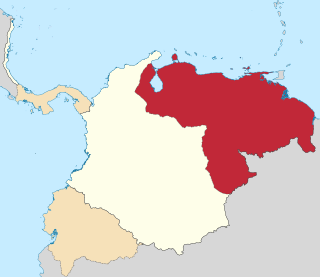
Venezuela Department was one of the three departments of Gran Colombia until 1824.
Spanish expeditions led by Columbus and Alonso de Ojeda reached the coast of present-day Venezuela in 1498 and 1499. The first colonial exploitation was of the pearl oysters of the "Pearl Islands". Spain established its first permanent South American settlement in the present-day city of Cumaná in 1502, and in 1577 Caracas became the capital of the Province of Venezuela. There was also for a few years a German colony at Klein-Venedig.
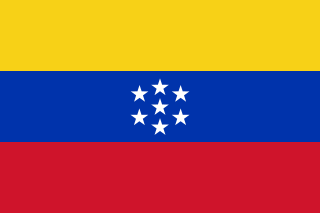
The United States of Venezuela was the official name of Venezuela, adopted in its 1864 constitution under the Juan Crisóstomo Falcón government. This remained the official name until 1953, when the constitution of that year renamed it the Republic of Venezuela. In 1999 under newly elected president Hugo Chavez and his modification to the Constitution, Venezuela's official name became the Bolivarian Republic of Venezuela.













